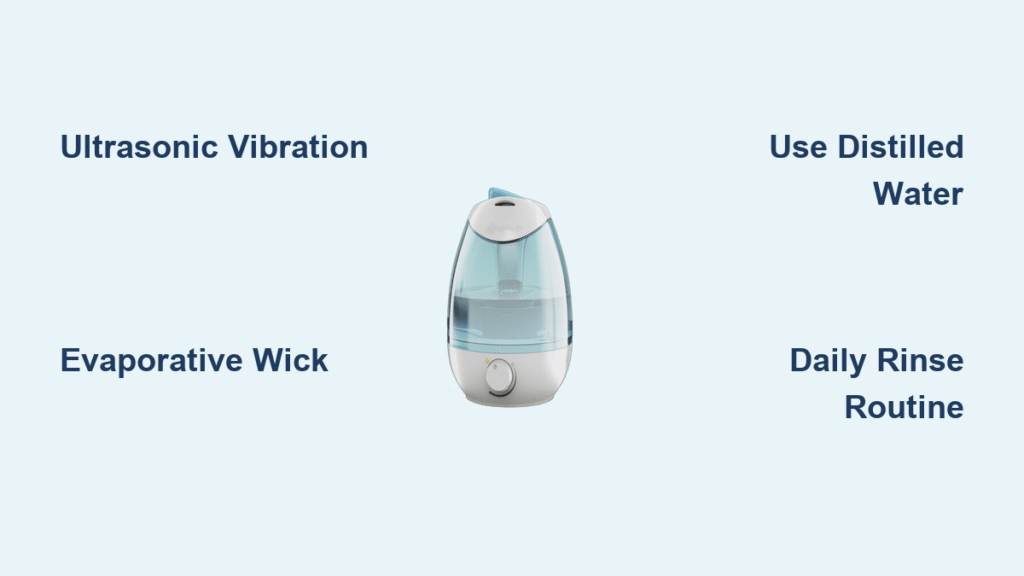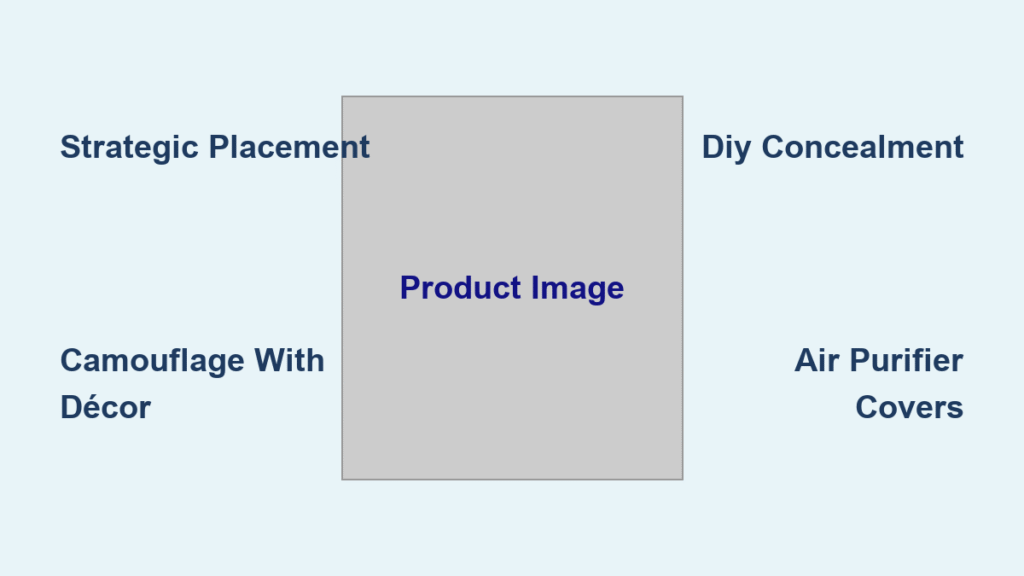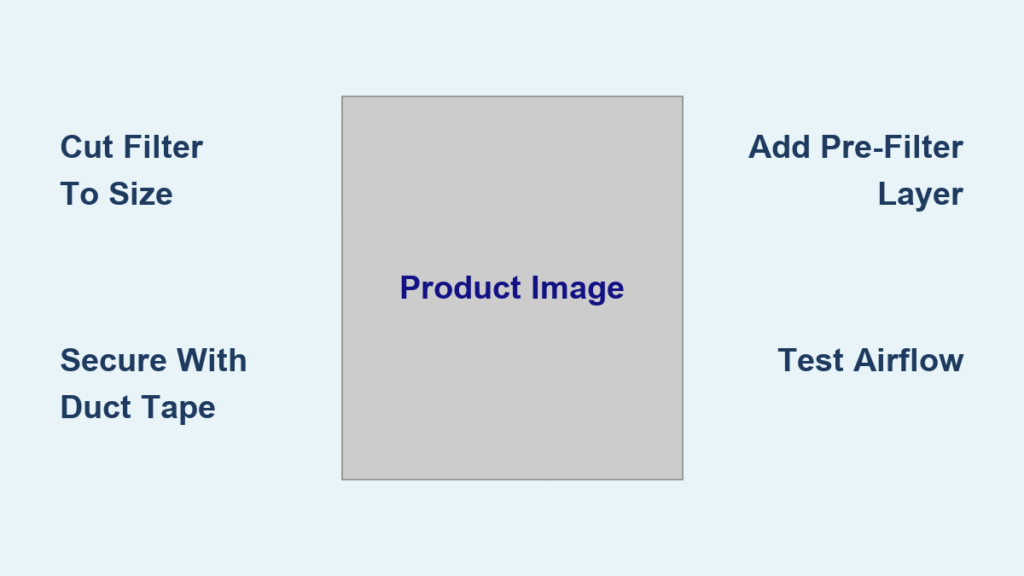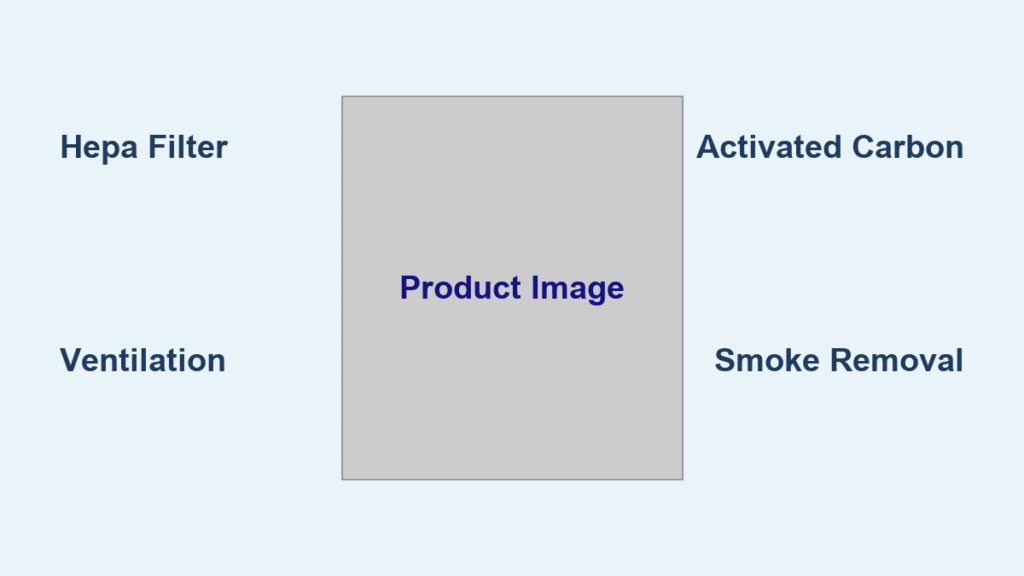Your throat scratches with every swallow, static shocks zap you when touching doorknobs, and your wooden furniture develops hairline cracks. Dry indoor air isn’t just uncomfortable—it worsens allergies, triggers asthma, and damages your home. Before you resort to ineffective hacks like boiling pots of water, understand how does a cool mist humidifier work to safely add moisture without heating elements. These devices combat winter dryness and summer arid conditions using room-temperature water, making them energy-efficient and child-safe. You’ll learn exactly how ultrasonic vibrations and evaporative wicks transform tap water into invisible humidity—plus critical maintenance steps to avoid white dust or mold.
Ultrasonic Humidifiers: Shatter Water with High-Frequency Sound Waves
Unlike warm mist models that boil water, ultrasonic units use inaudible sound vibrations to create mist. Inside every unit, a piezoelectric disc oscillates at 1.6–2.4 million times per second—faster than human hearing detects. This rapid movement generates microscopic bubbles in the water reservoir that implode violently, fracturing water into particles 0.5–5 micrometers wide (smaller than red blood cells). You’ll see a visible mist plume rising from the outlet, but the water never exceeds room temperature.
How the Piezoelectric Disc Creates Micro-Droplets in 60 Seconds

The moment you power on an ultrasonic humidifier, the ceramic disc starts vibrating against the water surface. Within one minute:
– Cavitation bubbles form and collapse under pressure changes
– Water molecules separate into breathable micro-droplets
– Droplets float upward due to natural convection
Critical visual cue: If the mist plume appears weak or disappears, scale buildup is likely damping the disc’s vibrations—requiring immediate descaling (covered in troubleshooting).
Why the Fan Matters for Even Humidity Distribution
A whisper-quiet fan (25–35 dB) sits just above the vibrating disc to propel mist into your room. Without this fan, droplets would settle back into the tank. The fan’s low speed ensures silent operation—ideal for bedrooms—but must run continuously during use. If you notice mist pooling near the unit, reposition it 2–3 feet above floor level and away from walls to prevent moisture buildup on surfaces.
Eliminate White Dust from Hard Water in 3 Steps
Tap water minerals like calcium hitchhike on mist particles, leaving chalky residue on furniture. Fix this permanently by:
1. Using distilled water (zero minerals) instead of tap water
2. Installing demineralization cartridges that absorb calcium/magnesium
3. Replacing cartridges every 30–40 tank refills (or 2–3 months)
Pro tip: In hard water areas (over 150 ppm), evaporative humidifiers skip this issue entirely—their wicks trap minerals.
Evaporative Humidifiers: Natural Moisture Release via Wick Filters
These units mimic nature’s evaporation process without heat. A porous wick filter—made of paper, foam, or cloth—sits partially submerged in the water tank. Through capillary action (like a candle wick absorbing wax), it draws water upward until saturated. As dry room air passes through the wet filter, moisture evaporates directly into the air stream. The key? No visible mist plume—just pure humidity.
Why Wick Filters Self-Regulate Humidity Levels
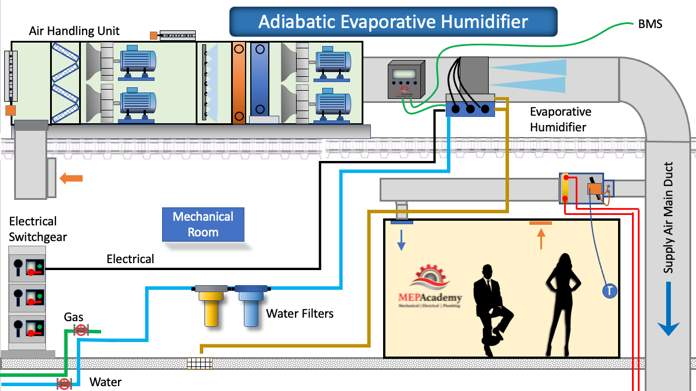
Evaporative humidifiers have an automatic safety feature ultrasonic models lack. As room humidity rises, the air’s ability to absorb moisture decreases, naturally slowing evaporation. This prevents over-humidification and window condensation—a critical advantage for forgetful users. If your hygrometer reads above 50% RH, the unit will visibly reduce output without manual adjustment.
How Filters Capture Minerals and Allergens Safely
The wick acts as a physical barrier that traps:
– Calcium and magnesium (eliminating white dust)
– Airborne pollen and dust particles
– Bacteria attempting to pass through
Expert note: Replace wicks every 4–8 weeks. Stiff, discolored, or musty-smelling filters lose effectiveness and can harbor mold.
Why Cool Mist Humidifiers Save 80% More Energy Than Warm Mist
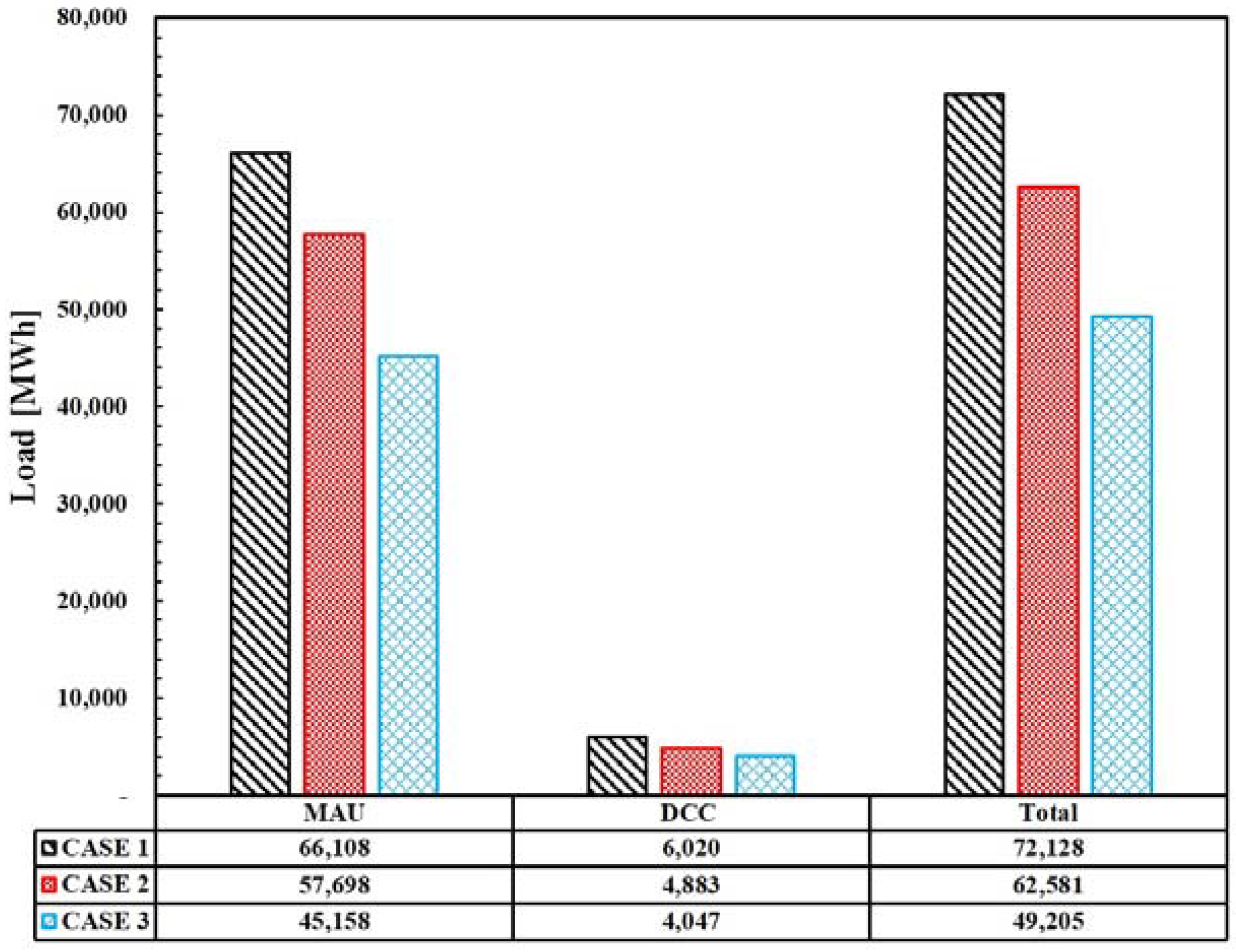
Boiling water for warm mist humidifiers guzzles 200–400 watts—comparable to a slow cooker. Cool mist alternatives use just 20–60 watts (less than a nightlight):
– Ultrasonic: 0.2–0.4 kWh daily ($0.03–$0.05 cost)
– Evaporative: 0.3–0.7 kWh daily ($0.04–$0.09 cost)
– Warm mist: 2–4 kWh daily ($0.30–$0.60 cost)
Over three winter months, this saves $30–50 while eliminating scald risks. Pediatricians universally recommend cool mist for children’s rooms—water stays room-temperature, preventing burns if knocked over.
Optimal Humidity and Noise Levels for Every Room
Hit the 30–50% RH Sweet Spot Without Guesswork
Health agencies mandate 30–50% relative humidity for health and home protection:
– Winter: Target 30–35% RH to prevent window condensation
– Summer: Allow up to 50% RH for comfort
– Non-negotiable: Use a $10 digital hygrometer—built-in sensors fail 70% of the time
Warning: Exceeding 50% RH invites mold growth in walls and carpets.
Choose Quiet Operation for Light Sleepers
| Humidifier Type | Noise Level | Best For |
|---|---|---|
| Ultrasonic | 25–35 dB (library-quiet) | Nurseries, bedrooms |
| Evaporative | 35–50 dB (refrigerator hum) | Living rooms, offices |
| Warm mist | 35–45 dB (gurgling) | Not recommended for kids |
Ultrasonic models win for sleep-sensitive users—many report forgetting the unit runs.
Stop Mold in Cool Mist Humidifiers: Daily and Weekly Cleaning Routines
Stagnant water breeds biofilm in 48 hours, aerosolizing bacteria into your air. Avoid this with military-precision cleaning:
Daily 60-Second Rinse Protocol

- Unplug and empty unused water (never reuse stagnant water)
- Rinse tank and base under running water
- Wipe interior with microfiber cloth
- Air-dry completely before refilling
Critical mistake: Skipping daily rinses causes “humidifier lung”—a serious respiratory condition.
Weekly Deep Clean That Kills 99.9% of Mold
- Soak tank/base in 1:3 white vinegar solution for 30 minutes
- Scrub scale with soft brush (never metal—it damages sensors)
- Rinse until vinegar smell vanishes (3–4 times)
- Replace wicks if discolored or stiff
Pro tip: Drop a Protec Cleaning Fish in the tank—it releases antimicrobial agents between cleanings.
Fix No Mist, White Dust, or Odors in Your Cool Mist Humidifier
Troubleshoot Zero Mist Output in 2 Minutes

| Symptom | Ultrasonic Fix | Evaporative Fix |
|---|---|---|
| No mist | Descale nebulizer disc with vinegar | Replace dry/cracked wick |
| Weak mist | Clean fan vents with cotton swab | Unclog water inlet holes |
| Intermittent mist | Ensure water level covers sensor | Check fan motor for obstructions |
Visual check: If ultrasonic mist plume is uneven, the disc is partially scaled.
Eliminate Musty Odors Caused by Biofilm
- Run unit empty with 1 cup undiluted white vinegar for 30 minutes
- Scrub tank corners with toothbrush (mold hides in crevices)
- For severe cases: Soak in 1 tbsp bleach per liter for 10 minutes
- Always rinse 5x after bleach use
Never ignore odors—biofilm can trigger asthma attacks.
Select the Perfect Cool Mist Humidifier for Your Room Size and Water Hardness
Match Capacity to Your Square Footage
- 0.5–1L tanks: Personal use (desks, bedside tables) for ≤150 sq. ft.
- 2–4L tanks: Bedrooms (200–400 sq. ft.)—runs 8–12 hours overnight
- 4–10L tanks: Living rooms (500–1,000 sq. ft.)—refill every 24h
Hard water alert: If your area has >150 ppm minerals, choose evaporative models or pair ultrasonic with demineralization cartridges.
Critical Features for Allergy Sufferers
- Evaporative units with antimicrobial wicks trap pollen and dust
- UV-C light models (like Honeywell HCM-350) kill airborne bacteria
- Avoid ultrasonic units if using tap water—they aerosolize contaminants
Your First 5 Minutes with a New Cool Mist Humidifier
- Fill with distilled water—never tap water for ultrasonic models
- Position 2–3 feet above floor away from electronics (mist damages circuits)
- Set hygrometer to 40% RH—adjust as seasons change
- Insert demineralization cartridge if using hard tap water
- Start daily rinse habit immediately—prevents 90% of issues
Time-saving hack: Top-fill models (like Crane) cut refill time by 50% versus bottom-fill tanks.
Understanding how does a cool mist humidifier work transforms it from a simple appliance into a targeted dry-air solution. Ultrasonic models shatter water with silent vibrations, while evaporative units leverage natural wick-based evaporation—both avoiding dangerous heat and slashing energy use by 80%. Remember: distilled water prevents white dust, daily rinses stop mold, and your hygrometer is non-negotiable for healthy 30–50% humidity. Within 24 hours of proper use, you’ll breathe easier, sleep deeper, and protect your home from dry-air damage. Start tonight with distilled water, correct placement, and that 60-second daily rinse—it’s the only maintenance that guarantees clean, safe humidity all winter.

